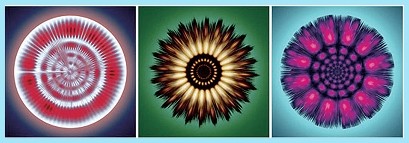| The Sentient World of Animals |
| Sonic Communication of Whales |
Scientific research carried out by marine biologist Peter Tyack shows that whales communicate in complex, repetitive sound patterns. Using wavelets, a technique for processing digital signals, Mark Fischer, an engineer from Northern California, was able to transform these patterns into movies and beautiful still images which look like sonic mandalas. Wavelets pick up nuances that may be missed by the human ear or less sophisticated visualization methods.
 |
Mark Fischer found a mathematical
tool to translate the subtlety and nuance of whale and dolphin sounds
into these mandala-like images. |
By comparison, all whale species have their own unique patterns and resonance, described by Mr. Fischer as auditory fingerprints. “I don’t think anyone has ever spent even a little time around a whale and not been amazed by it,” Mr. Fischer said in an interview. Dr. Peter Tyack, a senior scientist at Woods Hole Oceanographic Institution, sees this as not only art, but as a scientific research tool. He believes that repetitions in whale songs follow grammatical rules similar to those of human language. “It looked like you could see a lot of repeated units,” Dr. Tyack said.
Mr. Fischer gives many people a glimpse
of a world they would otherwise never experience. He is inspiring a greater
appreciation of whales among both marine biologists and the public by
merging science and art. He explains, “When you see what whales
are doing with sound, or begin to see what they are capable of, it is
clear that humans are not the only artists on the planet.”
![]()
| << | Contents | >> |
|
Refer this page to friends
|
||